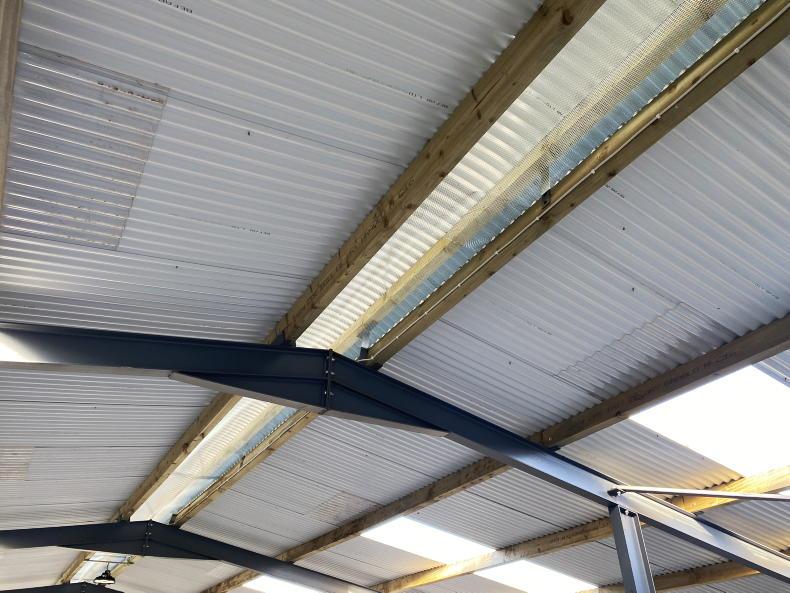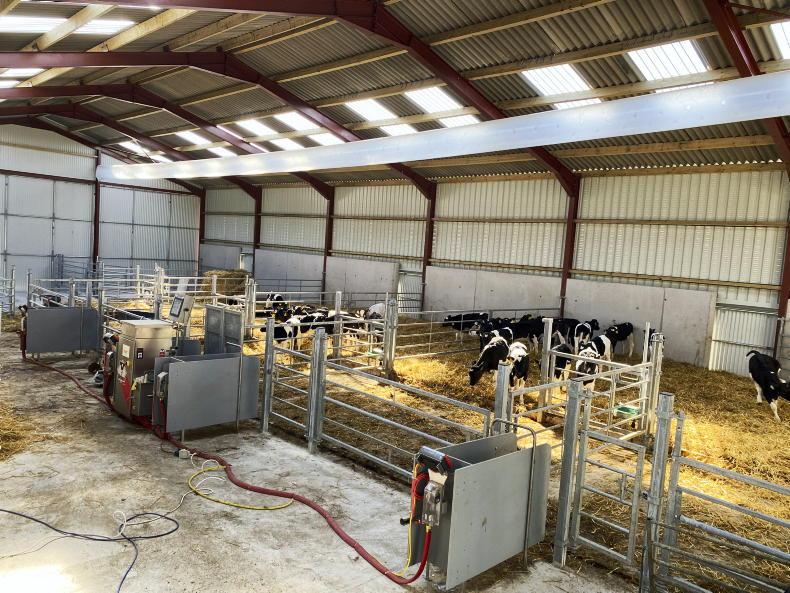I have recently converted a haybarn into a calf shed. It measures 46ft by 31ft. How many calves can I fit in this shed?
The minimum recommended space allowance per calf is 2m2 and the majority of this space should be lying area. Interestingly, very large space allowances per calf aren’t recommended so the 2m2 is a good rule of thumb.
Based on the measurements of the shed provided, it would take about 70 calves.
I had issues with pneumonia in calves last year. Should I vaccinate for RSV PI3 or install an artificial ventilation system?
It is difficult to answer this question without more details about the shed design and existing ventilation or indeed the cause of the pneumonia outbreak experienced last season.
If ventilation is an issue, as it is in most calf sheds, then fixing it should bring some positive benefits for calf health.
It’s important to remember that artificial ventilation systems do not extract stale air, they just push in fresh air so air outlets need to be appropriately sized. As for vaccination, the best policy is to seek veterinary advice specific to the risks on your farm.
What is the homemade recipe for scour powders?
Homemade electrolytes can be used instead of purchased electrolytes. A common recipe is as follows;
8g (half a tablespoon) of low salt.12g (one tablespoon) of bread soda. 40g (two to three tablespoons) of glucose.All of these ingredients are mixed in two litres of warm water. Some farmers will make up little sachets of these electrolytes and have them on hand if a calf gets sick.
My neighbour has all the young calves wearing jackets. Are they worth it?
The thinking on calf jackets is slowly changing from that of unnecessary expense to important in certain circumstances.
According to Teagasc, the optimal temperature for rearing calves is 150C to 200C, which is not a common temperature we get in February or March.
In cold sheds or where calves are weak or sick or very young, then a calf jacket will help to bring up their temperature and should lead to improved performance.
Research on calf jackets in Ireland hasn’t shown a major benefit when calves are indoors in good housing.
Calf jackets need to be adjustable, appropriately sized and washed between calves. Installing heat lamps in a calf pen might be easier and just as beneficial.
What’s the best treatment for scour in calves?
It is dehydration that is the main cause of mortality in most incidences of calf scours.
The temptation is to cut back on milk when calves have scour but this the incorrect thing to do as it is actually additional fluids that the calf needs during this time.
Feeding two or three feeds per day of electrolytes in between the main milk feeds will help to ensure that the fluids being lost through the scour are being replaced.
Damage to the gut prevents the nutrients in the milk from being absorbed properly
Remember, the scour occurs when the calf’s gut is being attacked by a virus or parasite.
Damage to the gut prevents the nutrients in the milk from being absorbed properly and so it passes through the calf, hence very loose and watery faeces are the main symptoms of scour.
How do you prevent scour in the first place?
The best prevention for scour is to focus on maintaining the calf’s immunity.
Anything that wears this down opens the door for scour or other diseases to take hold. This starts with sufficient colostrum as being the number one prevention.
A good, deep bed, sufficient high-quality milk or milk replacer fed through clean equipment and good ventilation are the building blocks of successful calf rearing.
Prevent disease coming into the yard by keeping visitors away from the calf shed and for the farmer to avoid entering calf sheds on other farms, wear different clothing and footwear to the mart, etc.
If a calf does get scour, isolate it straight away to limit the spread.

Air outlet in the ridge.
How often do calf pens need to be cleaned out?
This varies depending on the slope in the floor and how many calves are in the pen but, in general, the more regularly the shed is cleaned out the better.
Continuously topping up the bed with straw will lead to a buildup on ammonia at the floor and a buildup of bugs and bacteria.
Having said that, some farmers “get away” with cleaning out the pen very little during the season but make a special effort to ensure that calves always have a good, deep bed of fresh straw under them at all times.
That is probably more important than regular cleaning.
What is the minimum age to bring calves to the mart?
Calves can be moved off a holding from 10 days of age either to the mart or in a farm-to-farm sale.

A well-ventilated calf shed.
However, calves must be 14 days of age before they can be exported so exporters or their agents won’t buy a calf less than 14 days of age.
Exporters are increasingly looking at weight, rather than just age with 50kg liveweight the new benchmark for calves destined for export.
I have recently converted a haybarn into a calf shed. It measures 46ft by 31ft. How many calves can I fit in this shed?
The minimum recommended space allowance per calf is 2m2 and the majority of this space should be lying area. Interestingly, very large space allowances per calf aren’t recommended so the 2m2 is a good rule of thumb.
Based on the measurements of the shed provided, it would take about 70 calves.
I had issues with pneumonia in calves last year. Should I vaccinate for RSV PI3 or install an artificial ventilation system?
It is difficult to answer this question without more details about the shed design and existing ventilation or indeed the cause of the pneumonia outbreak experienced last season.
If ventilation is an issue, as it is in most calf sheds, then fixing it should bring some positive benefits for calf health.
It’s important to remember that artificial ventilation systems do not extract stale air, they just push in fresh air so air outlets need to be appropriately sized. As for vaccination, the best policy is to seek veterinary advice specific to the risks on your farm.
What is the homemade recipe for scour powders?
Homemade electrolytes can be used instead of purchased electrolytes. A common recipe is as follows;
8g (half a tablespoon) of low salt.12g (one tablespoon) of bread soda. 40g (two to three tablespoons) of glucose.All of these ingredients are mixed in two litres of warm water. Some farmers will make up little sachets of these electrolytes and have them on hand if a calf gets sick.
My neighbour has all the young calves wearing jackets. Are they worth it?
The thinking on calf jackets is slowly changing from that of unnecessary expense to important in certain circumstances.
According to Teagasc, the optimal temperature for rearing calves is 150C to 200C, which is not a common temperature we get in February or March.
In cold sheds or where calves are weak or sick or very young, then a calf jacket will help to bring up their temperature and should lead to improved performance.
Research on calf jackets in Ireland hasn’t shown a major benefit when calves are indoors in good housing.
Calf jackets need to be adjustable, appropriately sized and washed between calves. Installing heat lamps in a calf pen might be easier and just as beneficial.
What’s the best treatment for scour in calves?
It is dehydration that is the main cause of mortality in most incidences of calf scours.
The temptation is to cut back on milk when calves have scour but this the incorrect thing to do as it is actually additional fluids that the calf needs during this time.
Feeding two or three feeds per day of electrolytes in between the main milk feeds will help to ensure that the fluids being lost through the scour are being replaced.
Damage to the gut prevents the nutrients in the milk from being absorbed properly
Remember, the scour occurs when the calf’s gut is being attacked by a virus or parasite.
Damage to the gut prevents the nutrients in the milk from being absorbed properly and so it passes through the calf, hence very loose and watery faeces are the main symptoms of scour.
How do you prevent scour in the first place?
The best prevention for scour is to focus on maintaining the calf’s immunity.
Anything that wears this down opens the door for scour or other diseases to take hold. This starts with sufficient colostrum as being the number one prevention.
A good, deep bed, sufficient high-quality milk or milk replacer fed through clean equipment and good ventilation are the building blocks of successful calf rearing.
Prevent disease coming into the yard by keeping visitors away from the calf shed and for the farmer to avoid entering calf sheds on other farms, wear different clothing and footwear to the mart, etc.
If a calf does get scour, isolate it straight away to limit the spread.

Air outlet in the ridge.
How often do calf pens need to be cleaned out?
This varies depending on the slope in the floor and how many calves are in the pen but, in general, the more regularly the shed is cleaned out the better.
Continuously topping up the bed with straw will lead to a buildup on ammonia at the floor and a buildup of bugs and bacteria.
Having said that, some farmers “get away” with cleaning out the pen very little during the season but make a special effort to ensure that calves always have a good, deep bed of fresh straw under them at all times.
That is probably more important than regular cleaning.
What is the minimum age to bring calves to the mart?
Calves can be moved off a holding from 10 days of age either to the mart or in a farm-to-farm sale.

A well-ventilated calf shed.
However, calves must be 14 days of age before they can be exported so exporters or their agents won’t buy a calf less than 14 days of age.
Exporters are increasingly looking at weight, rather than just age with 50kg liveweight the new benchmark for calves destined for export.








 This is a subscriber-only article
This is a subscriber-only article











SHARING OPTIONS: